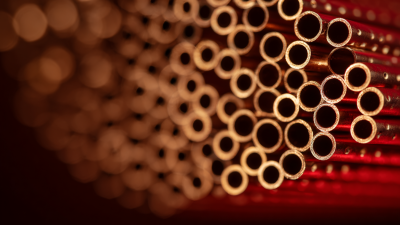Leave Your Message
In the rapidly evolving landscape of packaging solutions, the introduction of laminate tubes has emerged as a game-changer for various industries, particularly in cosmetics, pharmaceuticals, and food products. According to a recent industry report, the global laminate tubes market is projected to grow at a CAGR of 6% from 2022 to 2028, driven by rising consumer demand for sustainable and user-friendly packaging options. Laminate tubes offer unparalleled benefits such as lightweight construction, exceptional barrier properties, and customizable designs, making them ideal for preserving product integrity while enhancing brand appeal. As businesses increasingly focus on sustainability, innovative materials, and efficient manufacturing processes, laminate tubes are poised to play a crucial role in reshaping packaging norms. This blog will delve into the seven key reasons why laminate tube products are revolutionizing the packaging sector, illustrating their transformative impact on both consumers and manufacturers alike.

In today’s fast-paced world, laminate tube products are redefining packaging solutions with their array of benefits. One of the most significant advantages is their versatility. Laminate tubes can accommodate a variety of products, from creams and gels to food items, making them an ideal choice for brands seeking a single solution for diverse packaging needs. This adaptability not only simplifies inventory but also streamlines the production process, allowing businesses to respond swiftly to market demands.
Another key benefit lies in their protective properties. Laminate tubes provide superior barrier protection against light, moisture, and air, which is essential for preserving the quality and integrity of sensitive products. This feature extends shelf life, ensuring that consumers experience the freshness and effectiveness intended by manufacturers.
Additionally, the lightweight nature of laminate tubes contributes to reduced shipping costs and a smaller environmental footprint, aligning with the increasing demand for sustainable packaging solutions in the modern marketplace.
Laminate tubes are becoming increasingly popular in packaging solutions, particularly due to their ability to enhance product shelf life and freshness. Unlike traditional packaging, laminate tubes are crafted using multiple layers of materials that provide superior barrier properties against moisture, light, and air. This protection is crucial in preventing contamination and degradation of products, ensuring that consumers receive items in their best condition.
One of the best tips for brands considering laminate tubes is to prioritize the right materials for their specific products. For instance, if you are packaging food items, opt for laminate that effectively blocks UV light, as this will help preserve flavor and nutritional value. Additionally, companies should focus on proper sealing technologies, as an airtight seal further extends shelf life and maintains product integrity.
Another essential tip is to take advantage of the customizable designs available with laminate tubes. Eye-catching graphics and branding can not only attract consumers but also communicate key information about the freshness and benefits of the product. By effectively marrying aesthetic appeal with functional advantages, brands can make a lasting impression while ensuring their products maintain peak quality throughout their shelf life.

The trend of using laminate tube packaging is gaining momentum, primarily due to its environmental benefits. Unlike traditional packaging materials, laminate tubes are often made from recyclable materials, significantly reducing waste and promoting a more sustainable approach to packaging. The materials used in laminate tubes not only help preserve the contents but also maintain their integrity over time, decreasing the likelihood of product spoilage and the associated environmental impact.
One notable tip for brands considering laminate tube packaging is to look for suppliers that utilize eco-friendly inks and adhesives. This small change can dramatically improve the overall sustainability of the packaging. Additionally, companies should explore incorporating recycled materials into their laminate tubes, thereby aligning with consumer demands for environmentally responsible products.
As consumers become more environmentally conscious, adopting laminate tube packaging can enhance a brand's appeal. Offering refillable options or encouraging consumers to recycle the tubes can further strengthen the sustainability message, creating a positive feedback loop between brand loyalty and environmental responsibility.
 Laminate tubes are quickly becoming a preferred choice in the packaging industry due to their cost-effectiveness compared to traditional packaging. Unlike glass or rigid plastic containers, laminate tubes are lighter and require less material, which significantly reduces production and shipping costs. This streamlined approach not only helps brands save money but also reduces their environmental footprint, making laminate tubes a smart choice for eco-conscious businesses.
Laminate tubes are quickly becoming a preferred choice in the packaging industry due to their cost-effectiveness compared to traditional packaging. Unlike glass or rigid plastic containers, laminate tubes are lighter and require less material, which significantly reduces production and shipping costs. This streamlined approach not only helps brands save money but also reduces their environmental footprint, making laminate tubes a smart choice for eco-conscious businesses.
When considering laminate tubes for your product, here are a few tips to maximize their benefits. First, ensure that you collaborate closely with manufacturers to explore various designs that can enhance usability without increasing costs. Secondly, consider the material composition; choosing high-quality laminates can improve product shelf life while maintaining affordability. Lastly, incorporate consumer feedback into your packaging design—understanding customer preferences can guide you in creating an attractive yet cost-effective solution that stands out in the market.
The transition to laminate tubes also presents opportunities for creative marketing strategies. Since these tubes can be printed in vibrant colors and intricate designs, brands can leverage this feature to attract consumers visually while maintaining budget constraints. Embracing this innovative packaging solution not only enhances branding efforts but also positions products competitively in an ever-evolving marketplace.
In recent years, consumer preferences have shifted significantly towards more sustainable and convenient packaging options. One of the most notable innovations in this realm is the laminate tube product. According to a report by Smithers Pira, the global flexible packaging market is expected to reach $300 billion by 2026, with laminate tubes playing a crucial role in this growth due to their lightweight design and ease of use. This transformation is driven not only by environmental awareness but also by the demand for products that enhance user experience and convenience.
Tips for brands looking to adopt laminate tube packaging include considering eco-friendly materials. Many consumers today are willing to pay a premium for sustainable packaging solutions. Research from the Sustainable Packaging Coalition revealed that 75% of consumers are concerned about packaging waste. Additionally, brands should focus on clear and attractive designs that communicate the product’s benefits effectively, as eye-catching packaging can greatly influence purchasing decisions in a crowded market.
Furthermore, laminate tubes offer versatility in packaging various products, from cosmetics to food items. This adaptability can cater to diverse consumer needs, allowing brands to tap into different market segments. Companies that embrace these packaging innovations can not only enhance their product appeal but also align themselves with the growing trend towards sustainability and consumer-centric design.
| Reason | Consumer Trend | Impact on Packaging | Market Adaptation |
|---|---|---|---|
| Sustainability | Rising demand for eco-friendly products | Reduction of plastic waste | Increased investment in biodegradable materials |
| Customization | Personalization preference among consumers | Bespoke packaging solutions | Flexible production processes for varied designs |
| Convenience | Demand for on-the-go products | Easier to use and transport | Adoption of innovative dispensing solutions |
| Barrier Properties | Extension of product shelf life | Enhanced preservation capabilities | Research into advanced laminate technologies |
| Lightweight | Preference for lightweight packaging | Reduces shipping costs | Shift towards lighter materials |
| Aesthetics | Visual appeal in consumer choices | Attractive product displays | Investments in design research and technology |
| Cost-Effective | Consumer price sensitivity | Competitive pricing advantages | Optimization of production processes |






